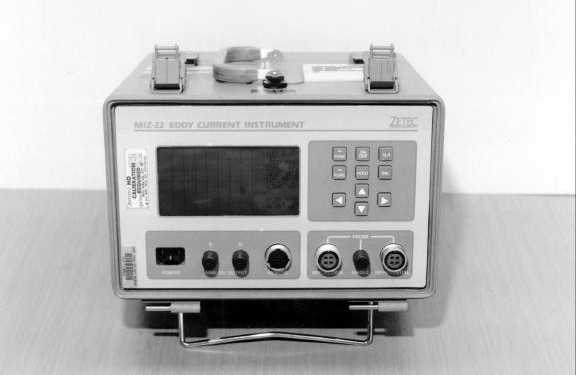T.O. 33B-1-1
4-47
Figure 4-40. ZETEC MIZ-22 Eddy Current Instrument.
4.4.3.23
Presentations And Displays.
The output from an eddy current instrument may be read on a meter, impedance plane display, or recorder, depending
upon the type of information required from the test. An analog (pointer) type meter is the simplest type of output
indicator. An output consisting of amplitude and phase is called an impedance plane display, and can be displayed on
either a cathode ray tube (CRT) or a digital display.
4.4.3.24
Meters.
Many of the portable flaw and conductivity testers use a meter that essentially indicates the degree of bridge unbalance
in terms of amplitude. Depending upon the instrument circuitry, phase differences may also be displayed on a meter.
Most eddy current instruments contain built-in output meters specifically designed or selected for use with the
particular circuitry involved. The meter should have a speed of response sufficient to detect the discontinuities of
interest at the highest expected scan speed. However, the meter should be sufficiently damped so that "noise"
indications do not confuse the inspector, but not damped to the point that information of interest may be missed.
Optimum meter response is a balance between speed of response and damping.
4.4.3.25
Cathode Ray Tube (CRT) Display.
The cathode ray tube (CRT) is a device for display and measurement of electrical phenomena. The CRT consists of
four basic parts: a glass envelope, and electron gun, a means of deflecting or controlling the electrons produced by the
gun, and a screen which transforms the electrical energy of the electrons from the gain into light. The screen consists
of a phosphor coating on the inside face of the glass envelope (tube). When electrons strike the screen, light is
generated. The relative length of time that the screen continues to glow or give off light after the electrons have gone is
termed persistency. Generally, CRT persistency is on the order of 0.1 to 1 second. Storage oscilloscopes contain
extremely long persistency CRTs, on the order of many minutes. Storage oscilloscopes are used in most CRT type eddy
current equipment. A CRT output is used on eddy current instruments where impedance plane analysis techniques are
required in order to separate test variable.

